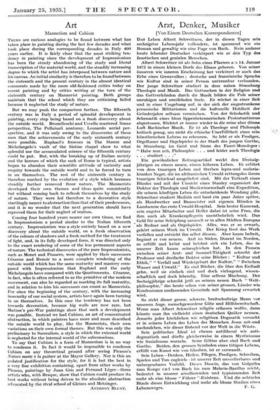Art
Mannerism and Cubism THERE are curious analogies to be found between what has taken place in painting during the last few decades and what took place during the corresponding decades in Italy 44)0 years earlier. It is fairly clear that the most striking ten- dency in painting since the development of Impressionism has been the steady abandoning of the study and literal transcription of the material world, and the steadily increasing degree to which the artist has interposed between nature and his canvas. An initial similarity is therefore to be found between the sixteenth and the present century in the almost identical comments made by the more old-fashioned critics today on recent painting and by critics writing at the turn of the sixteenth century on Mannerist painting. Both groups maintain that the school which they are criticizing failed because it neglected the study of nature.
But we may push the comparison further. The fifteenth century was in Italy a period of splendid development in painting, every step being based on a fresh discovery about the outside world. Brtmelleschi and Uccello mastered linear perspective, The Pollaiuoli anatomy, Leonardo aerial per- spective, and it was only owing to the discoveries of these men that the achievements of the early sixteenth century were possible. Raphael's frescoes in The Stanze and Michelangelo's vault of the Sistine chapel show to what splendid use the accumulated science of the fifteenth century could be put. But, with the breaking up of Italian society and the horrors of which the sack of Rome is typical, artists began to abandon their scientific attitude of curiosity and enquiry towards the outside world and to be forced to turn in on themselves. The rest of the sixteenth century is therefore marked by the evolution of a style which becomes steadily further removed - from nature. The Mannerists developed their own themes and ideas quite consistently but without coming back to refresh themselves by the study of nature. They were led therefore to a decorative style startlingly nearer to abstraction than that of their predecessors, and it is no wonder that the next generation should have reproved them for their neglect of realism.
Coming four hundred years nearer our own times, we find in Impressionism a period similar to the Italian fifteenth century. Impressionism was a style entirely based on a new discovery about the outside world, on a fresh observation of the colours of shadows and a fresh method for the treatment of light, and, in its fully developed form, it was directed only to the exact rendering of some of the less permanent aspects of nature. The technical discoveries of the pure Impressionists, such as Monet and Pissarro, were applied by their successors Cezanne and Renoir to a more complete rendering of the outside world which has the same maturity and mastery com- pared with Impressionism that Raphael and the early Michelangelo have compared with the Quattrocento. Cezanne, in fact, who is often referred to as the primitive of the modern movement, can also be regarded as marking its full maturity, and in relation to him his successors can count as Mannerists. For since the beginning of the century, with the increasing insecurity of our social system, artists have again been turning in on themselves. In this case the tendency has not been towards decoration, because big walls are now rare, but Matisse's pre-War paintings show that such a development was possible. Instead we had Cubism, an art of concentrated abstraction, in which painters have more and more described the outside world to play, like the Mannerists, their own variations on their own formal themes. But this was only the preliminary to Surrealism, a style in which the external world is neglected for the internal world of the subconscious.
To say that Cubism is a form of Mannerism is in no way to condemn it. In fact it would be impossible to condemn Cubism on any theoretical ground after seeing Picasso's Nature morte a la guitare at the Mayor Gallery. Nor is this an isolated justification for the style, for it is but the best in a very fine exhibition containing, apart from other works by Picasso, paintings by Juan Gris and Fernand Leger—three artists who, with Braque, show that Cubism, could produce its best works without being driven to the absolute abstraction advocated by the rival school of Gleizes and Metzinger.
ANTHONY BLUNT.














































 Previous page
Previous page